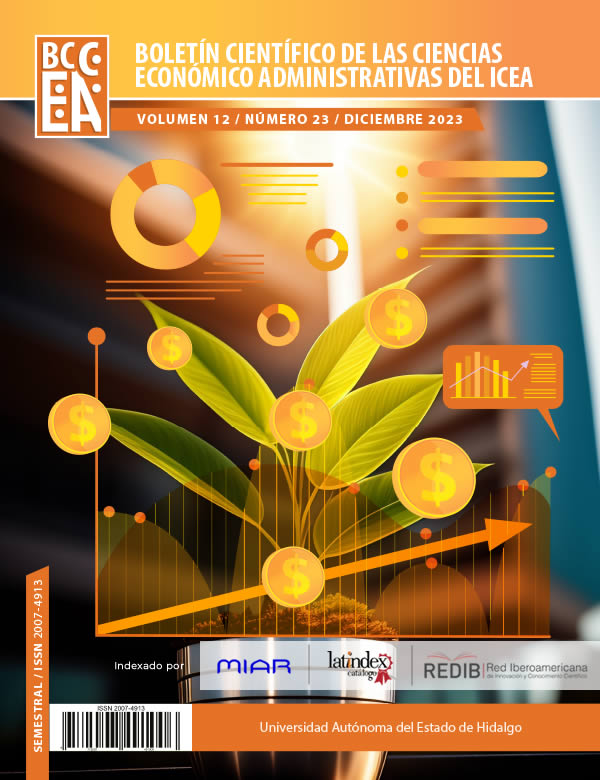Capacidad antioxidante del acaí (Euterpe Oleracea Mart.) y su efecto sobre las enfermedades crónica degenerativas
Resumen
El acaí es el fruto de la palmera Euterpe oleracea (nativa de la selva amazónica brasileña), tiene forma de baya pequeña y de color purpura oscuro, similar a una uva negra o a un arándano grande. Se ha informado que su consumo ya sea en pulpa o semilla, ejerce un efecto positivo principalmente para la salud cardiovascular, debido a su contenido de antioxidantes como son las antocianinas [cianidin 3-rutinosido (1,93 mg / g de peso seco) y cianidin 3- glucósido (1,17 mg / g de peso seco)]. Las antocianinas presentan una capacidad antioxidante, lo cual inhiben a los radicales libres y protegen a las células del daño oxidativo.
Descargas
Citas
Garzon G. (2017). Polyphenolic composition and antioxidant activity of açai (Euterpe oleracea Mart.) from Colombia. Food Chem. 217 (1): 364-372.
. Aliaño-González M. (2020). Extracción de antocianinas y compuestos fenólicos totales de Açai (Euterpe oleracea Mart.) Utilizando una metodología de diseño experimental. Parte 2: extracción asistida por ultrasonido. Agronomy. 10 (3), 326.
. Rioja A. (2018). Determinación de la capacidad antioxidante total, fenoles totales, y la actividad enzimática en una bebida no láctea en base a granos de chenopodium quinoa. Rev. Bol. Quim. 35 (5): 168-176.
. Sanabria, N., Sangronis, E. (2007). Caracterización del açaí o manaca (Euterpe olerácea Mart.): un fruto del Amazonas. Archivos Latinoamericanos de Nutrición. 5(1):94-98.
. Lichtenthäler R., (2004). Total oxidant scavenging capacities of Euterpe oleracea Mart. (Acaí) fruits. Int J Food Sci Nutr. 56(1): 53-64.
. Gallori S. (2004) Polyphenolic Constituents of Fruit Pulp of Euterpe oleracea Mart. (Ac¸ai palm). Chromatographia. 59 (1):739–743.
. Kanj J. (2012). Bioactivities of açaí (Euterpe precatoria Mart.) fruit pulp, superior antioxidant and anti-inflammatory properties to Euterpe oleracea Mart. Food Chemistry. 133 (1): 671–677.
. Ozgen M., Reese R. (2006). Modified 2,2-azino-bis-3-ethylbenzothiazoline-6-sulfonic acid (abts) method to measure antioxidant capacity of selected small fruits and comparison to ferric reducing antioxidant power (FRAP) and 2,20 -diphenyl-1-picrylhydrazyl (DPPH) methods. Journal of Agricultural and Food Chemistry, 54, 1151–1157.
Kuskoski E. (2005). Aplicación de diversos métodos químicos para determinar actividad antioxidante en pulpa de frutos. Ciênc. Tecnol. Aliment. 25 (4): 726-732
. OMS. 61ª Asamblea Mundial de la Salud. Prevención y control de las enfermedades no transmisibles: aplicación de la estrategia mundial [internet]. 2020. [Citado Julio de 2020]. Disponible en: http://www.who.int/gb/ebwha/pdf_files/ A61/A61_8-sp.pdfRevisado 25/07/20]
. Robaina G., (2017). Low birth weight, prematurity and chronic diseases in adulthood. Rev. Cubana Pediátrica. 89 (2): 108-112.
. Fuentes L. (2015). Alimentos funcionales: impacto y retos para el desarrollo y bienestar de la sociedad colombiana. Biotecnología en el Sector Agropecuario y Agroindustria. 13 (2): 140-149.
. Schauss, A., Wu, X., Prior, R., Ou, B., Huang, D., Owens, J., Agarwal, A., Jensen, G., Hart, A. y Shanbrom, E. (2006). Antioxidant Capacity and Other Bioactivities of the Freeze-Dried Amazonian Palm Berry, Euterpe oleraceae Mart. (Açaí). Journal of Agricultural and Food Chemistry. 54(22): 8604-8610.
. Jensen, G., Ager, D., Redman, K., Mitzner, M., Benson, K. & Schauss, A. (2011). Pain Reduction and Improvement in Rage of Motion After Daily Consumption of an Açaí (Euterpe oleracea Mart.) Pulp-Fortified Polyphenolic-Rich Fruit and Berry Juice Blend. Journal of Medicinal Food. 14 (8): 702-711.
. Choi Y., Kim N. (2017). Açai berries inhibit colon tumorigenesis in azoxymethane/dextran sulfate sodium-treated mice. Gut Liver. 11: 243–252.
. Soares T. (2020). The Use of Euterpe oleracea Mart. As a New Perspective for Disease Treatment and Prevention. Biomolecules. 10: 813-846.
. Bem, G.F.; Costa, C. (2018) Antidiabetic effect of Euterpe oleracea mart. (açai) extract and exercise training on high-fat diet and streptozotocin-induced diabetic rats: A positive interaction. PLoS ONE. 13 (6): 1-19.
. Zapata-Sudo G., Da Silva, J. (2014). Oral treatment with Euterpe oleracea Mart. (açaí) extract improves cardiac dysfunction and exercise intolerance in rats subjected to myocardial infarction. BMC Complement. Altern. Med. 14: 227.
. Gale, A., Kaur R., Baker W. (2014). Hemodynamic and electrocardiographic effects of açaí berry in healthy volunteers: A randomized controlled trial. Int. J. Cardiol. 174: 421–423.
. Soares, E., Monteiro, E. (2017). Up-regulation of Nrf2-antioxidant signaling by açaí (Euterpe oleracea Mart.) extract prevents oxidative stress in human endothelial cells. J. Funct. Foods 37, 107–115.
. Nascimento V., Do Lima, C. (2016) Antioxidant effects of açaí seed (Euterpe oleracea) in anorexia-cachexia syndrome induced by Walker-256 tumor. Acta Cir. Bras. 31: 597–601.
Derechos de autor 2023 Juan Ramírez Godínez, José Alberto Ariza Ortega, Gerardo Torres Nah

Esta obra está bajo licencia internacional Creative Commons Reconocimiento-NoComercial-SinObrasDerivadas 4.0.












